Mushroom Risotto: Dinner with a real Fungi
/First, let me just apologize for that horrendous pun. Usually I am the first to roll my eyes when the hubs chimes in with a doofy little quip but mushroom-based humour in all of its forms always gets my number.
Mention the word ‘risotto’ to anyone who does not find refuge in the kitchen and I guarantee you their eyes will gloss over. Yes, they may love that creamy, satisfying dish, but the idea of standing by a stove for 45 minutes constantly tending to what really amounts to be a pan of oddly cooked rice would make most roll their eyes, pick up the phone, and order a pizza.
But I am here to banish this myth that risotto is a tricky, time consuming dish to make! It is truly a simple little one-pot meal that is much less finicky than many recipes would have you believe.
This rich and dreamy mushroom risotto only takes a bit of chopping, some heating, and an occasional stir or two upon the addition of some stock. Finished with a little bit of vinegar to banish the stodginess that mushrooms sometimes bring and topped with a scattering of pecorino cheese, parsley, and tarragon, this little number will have you popping back into the kitchen for a second (read: third) helping.
Mushroom Risotto
Serves 4 as a main, more as a side
4 – 6 cups vegetable or chicken stock, preferably low/no sodium
3 tbsp extra virgin olive oil, divided
2 tsp butter
½ medium cooking onion, finely diced
2 cloves garlic, finely minced
12 cremini mushrooms, quartered
1 cluster oyster mushrooms, about the size of a softball, roughly torn
1 portobello mushroom, thinly sliced
1 ½ cups arborio rice
2 tbsp + ½ cup dry white wine, divided
2 tsp balsamic, red wine, or white wine vinegar
½ cup finely grated pecorino cheese, plus more for serving
1 tbsp finely chopped fresh tarragon, plus more for serving
1 tbsp finely chopped fresh parsley, plus more for serving
Salt and pepper, to taste
In a large skillet or frying pan, heat 1 tablespoon of olive oil over medium heat.
Bring the stock to a simmer in a medium saucepan and keep warm on the back burner over low heat. If you’d prefer, feel free to heat the stock in your microwave. You’ll just want to make sure that it is very warm when you go to add it to the risotto so you might need to zap it a few times throughout the process. If you are a lazy one today as I often am, don’t fret about heating the stock up at all. The recipe still works perfectly fine. It just might take a bit longer and be a bit more porridge-y which is an a-ok quality in my books.
When the oil is heated, add the chopped onion and season with some salt and pepper. Cook for about 3-5 minutes or just until the onions start to become tender. Turn the heat up to medium-high and add another tablespoon of oil to the pan along with the butter, garlic, and quartered cremini mushrooms. Season with a bit of salt and cook for about 3 minutes. Add the oyster mushrooms and thinly sliced portobello and cook until all the mushrooms have taken on a lovely golden colour. When the mushrooms are done, deglaze the pan with 2 tablespoons of wine and cook until evaporated. This will happen in the blink of an eye so stay with it. Once all of the wine has evaporated, transfer the mushrooms onto a plate and spread into a single layer. Set aside.
Place the pan back on the burner and reduce the heat to medium. Pour in the final tablespoon of olive oil and stir in the arborio rice. Continue stirring for about 1-2 minutes or until the rice begins to crackle a little and look a bit translucent around the edges. At this point, stir in ½ cup of white wine and cook until it has all evaporated.
Turn the heat down to medium-low and stir in the stock 1 - 1½ cups at a time, allowing it to bubble away and evaporate before the next addition. No need to worry about stirring constantly. Just give it a good whirl after each new addition and allow the stock to bubble away.
Continue adding the stock until the risotto is al dente or cooked to your liking. You’re aiming for a balance between tender and toothy but feel free to err on the textural side you prefer.
When the risotto is perfectly cooked, stir in the vinegar and about ½ cup more stock to loosen everything up, then add the mushrooms, pecorino, and your fresh herbs. Taste the risotto and adjust seasoning to your liking.
Serve in shallow bowls topped with pecorino, herbs, and a good dusting of freshly cracked black pepper.



